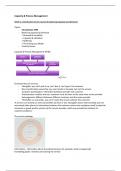Capacity & Process Management
Week 1; Introduction to the course & balancing Capacity and Demand
Topics;
- Introduction CPM
- Balancing Capacity & Demand
> Demand & variability
> Capacity & utilization
> Buffering
> The Erlang Loss Model
- Practical issues
Capacity & Process Management (CPM)
Characteristics of services;
- Intangible: you can’t pick it up, can’t buy it, can’t give it to someone
- Non-transferrable ownership: you can transfer a timeslot, but not the service
- Customer participation: interaction between provider and customer
- Simultaneous creation and use: customer must be there at the same time as the provider
- Heterogeneity: different between different customer and the same provider
- Perishable: as a provider, you can’t create the service without the customer
‘A service is an activity or series of activities of more or less intangible nature that normally, but not
necessarily takes places in interactions between the customer and service employees and/ or physical
resources or goods and/or systems of the service provider, which are provided as solutions to
customer problems.’
The service package;
Information: information about the patient process for example, what is happening?
Facilitating goods: material used during the service
,Supporting facility: resource/ the room/ equipment that you need by providing this service, this links
to Operation Management.
Operations Management;
‘The control of the activities involved in producing goods and providing services, and the study of the
best ways to do this.’
Health Service Operations Management;
‘Analysis, design, planning and control of all the steps necessary to provide services for patients in
such way that their needs are met, that service standards are met, and resources are used efficiently.’
> doing what the patients expects, doing what they need, but also on efficient use of resources → a
balance between two things.
HSOM: Process – Unit – Network
- Unit: a department in a health organization that performs operations of the same operations
type (shared unit does things for multiple patients, dedicated unit for one type of patients)
- Process/ chain: series of operations that need to be performed to produce a particular
service
- Network: combination of units and chains performing operations for services for several
groups of clients
Methodology: problem solving cycle;
…using models and analysis facilitate learning before doing
= Problem mess
➢ Problem definition
➔ Analysis & diagnosis: quantitative and qualitative analysis
➔ Solution design: compare all kinds of solution, then decide which intervention fits best
➔ Intervention
➔ Evaluation
➔ Problem definition
Financial Management; costs, income and investments
Resources must be available in the right amount, therefore we need financing, to buy and maintain
resources. Link between resources and operations is financing.
Topics in the course;
,Balancing capacity & demand
Capacity management – levels of planning
Planning is divided in three levels: levels determine what is possible in the level below
> Strategic level: sure that we have investments, enough resources, to perform operations.
> Tactical management: diving capacity over patients groups
> Operational planning: scheduling patients
If you do everything right, you have a smooth process
Example: opening theatre
Each room is dedicated for a specialty, for a specific time in the week. Within this capacity, those
specialties can plan their patients. These are tactical choices, which can change over time.
Second, operational planning is the other level.
Scheduling;
Decision that has to be made on the strategic level: how do we schedule patients?
- Walk in: patients are arriving, waiting, mostly first come, first serve.
- Appointment scheduling: most used in healthcare, allocating slots for patient groups, patient
gets a slot in the agenda, time for a slot is already determined. Problem here can be no
shows and there is some more management about this scheduling.
- Waiting lists: you gather requests for service on a list, based on prioritization and capacity,
you make a schedule. You try to optimize the schedule, efficiently using capacity.
, Demand, capacity & variability
Demand for our service, important to realize, who are our patients? When do we expect them? Is this
plannable or emergency? Both? Homogeneous or heterogonous patient group?
> We need to know this before deciding about scheduling and resources.
Capacity: access to the resource. For example, need MRI, room, room in preparation, medical staff.
We plan resources in certain way, always dependance between resources. Resources influence each
other. This can be a bottleneck, we have MRI scans but we don’t have beds. So then. MRI scans is
influenced.
if we have a constant flow, same number of patients every day, planning is easy, same resources are
needed. But this is not the case. You have to know something about variability when scheduling.
Same day capacity that is not used, some days that demand is for more than capacity. Variability is
thus very important.
Distinguish between predictable and unpredictable variability. For example, in fall, elderly fall which is
why there is a high demand on hip replacement. Viruses more in fall and winter. When you know
beforehand, you can try to adjust your capacity on it.





